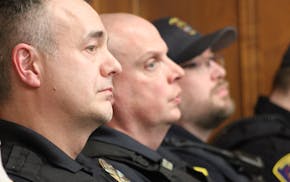Opinion editor's note: Strib Voices publishes a mix of guest commentaries online and in print each day. To contribute, click here.
•••
While 3 million Minnesotans were casting their votes last year, I was taking AP United States History and learning about the Revolutionary War. There, I came across Thomas Jefferson's famous proclamation in the Declaration of Independence that "Governments are instituted among Men, deriving their just powers from the consent of the governed." However, there is one glaring case in which elected officials make all the decisions that govern a constituency's lives; yet, that same constituency has no guaranteed power to give consent, feedback or oversight in the process. That case is school boards, and that constituency is young people.
Simply put, young people deserve the right to vote for student member representation on school boards across Minnesota. There is extensive research on why young people should be able to vote. As part of the Minnesota Youth Council's Policy Research Committee, I was the lead author of a research report (available at mnyouth.net/myc/advocacy) discussing why young people are qualified to vote as well as addressing what critiques and concerns remain. I invite all interested stakeholders to read over our report and consider its arguments.
Enfranchising youths with representation on school boards is uniquely critical. School boards are one of the most impactful institutions that shape the lives of young people. While they must operate within the guidelines of federal and state law, school boards have the ability to decide curriculum, set budgets, regulate extracurriculars and decide disciplinary standards. We young people spend a quarter of our day at school, and therefore have the greatest personal stake from the school board's decisions. Yet, Terry Morrow of the Minnesota School Boards Association recently testified that young people are only represented on 134 out of 331 school boards in Minnesota. While I applaud these 134 school districts for empowering youths with representation, we must recognize that the status quo is woefully insufficient, that to have the right to a voice in informing school board policy should extend to all of Minnesota's youths, not merely 40%. In the remaining 197 school districts, young people have no voice in district policies, no say in approving ballot referendums deciding if they can afford new textbooks and critical technology for their classrooms, and no way to ensure accountability for the school boards that intimately impact every aspect of their educational experience.
Having served on my city's Planning Commission, I had the privilege to comment on my high school's expansion and ensure that student parking and access would not be negatively impacted. Guaranteeing youth representation on school boards would expand opportunities like these to many more young people across our state and ensure that our diverse voices and perspectives are heard. In fact, including young people on school boards will enrich discussions and lead to new ideas in problem solving, because we are the ones who experience the problems facing schools and public education every day.
That is precisely why this year's Senate Education Policy omnibus bill is so impactful. It includes a provision that strongly encourages school boards to adopt a process to include two student representatives to advise the school board. While the final omnibus does not include a guarantee that every school district will indeed empower young people, it still represents a landmark endorsement by the Legislature of the ideal that young people deserve to be heard and represented in the institutions that govern our lives.
Certainly, there is still much work to be done. It's one thing to want the input, insight or involvement of young people, but another to actually empower us with substantive and meaningful representation at the decisionmaking table. I urge the Legislature to pass the omnibus bill with the above provision and continue this work next session to further expand the right of young people to shape our education with rigorous legislative guarantees and support. Behind every statistic is a story. For the 800,000 young people in Minnesota, please give us a chance to write our own future.
Daniel Song is a high school junior and representative on the Minnesota Youth Council, which is empowered by Minnesota statute as the official voice of young people statewide.

Olson's Cheers & Jeers: International Falls City Council wisely changes course
Opinion: 'Grease' at Chanhassen Dinner Theatres shows why we need to rethink nostalgia

Opinion: We're high school seniors, and coding changed our lives

